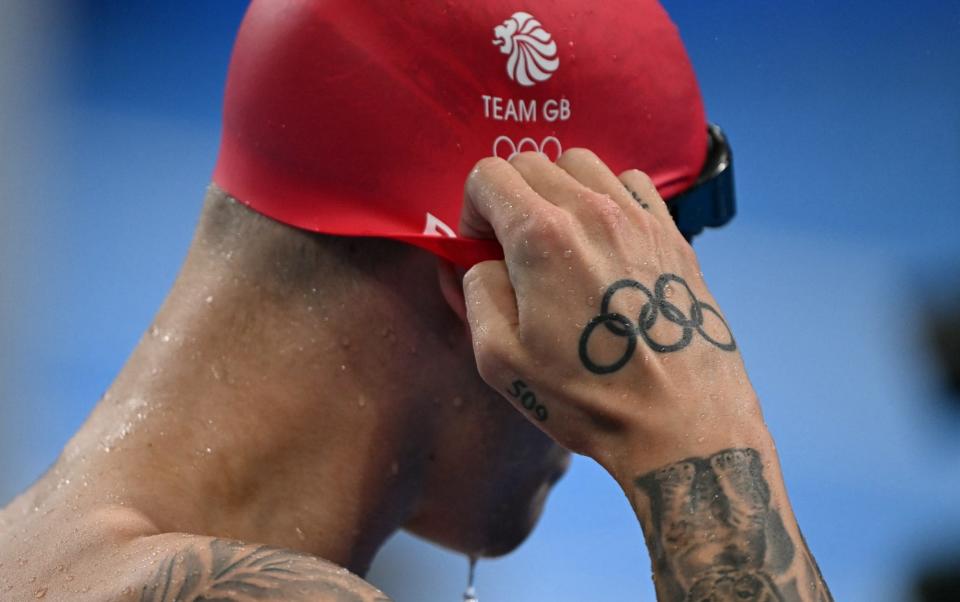Chris Jacobs brought home two gold medals and a silver medal from the 1988 Olympics, but also another meaningful souvenir. The swimmer’s route back to Texas from South Korea passed through Hawaii, where he decided to add the logo of his college team, the Texas Longhorns, to the tattoo on his hip. Between the horns were the Olympic rings, the earliest known example of a now-ubiquitous tattoo.
Many others have followed suit. Initially, it was swimmers, mostly Americans, who traditionally got their tattoos on an area covered by their swimsuit: the hips or the buttocks. But now athletes all over the world proudly wear the logo tattoos. Years later, Jacobs even got another tattoo on the inside of his biceps.
For Olympic athletes, getting one is both a rite of passage and the sacred moment in the village when they receive it. their brand name condoms.
Canadian swimmer Victor Davis was Jacobs’ inspiration. At Los Angeles 1984, he had a maple leaf visible on his left breast, so small it could be mistaken for a third nipple. It was rare to see a visible tattoo at the time and Jacobs decided to imitate it when he decompressed in Hawaii four years later.
“It was a chance to relax and let the goosebumps go away,” she says. “The Olympics had been a very intense experience, something completely different, unlike anything I had experienced before and very surreal.”
If Jacobs is the Bill Haley of ring tattoos, Michael Phelps and Ryan Lochte are its Lennon and McCartney. Lochte’s colorful rings on the inside of his right bicep became a familiar sight when he and Phelps (smaller, right hip usually partially hidden) were on their way to 40 medals in their Olympic prime.
“Like many other aspects of swimming, from the moment Michael Phelps got involved, it became a mainstream topic,” Jacobs says. “I know there were a lot of swimmers who did it before him and Ryan Lochte, but Phelps made swimming a popular sport in the United States and around the world.”
The tattoo is now so common that it would be quicker to name the athletes who don’t have one. Among the British contingent are Tom Daley (right bicep), Adam Peaty (left bicep), Mark Foster (left chest), Rebecca Adlington (lower back), gymnast Beckie Downie (right ankle) and canoeist Adam Burgess (right forearm). The Tahiti Olympic Village, situated on a boat, has an onboard tattoo parlour for surfers who wish to join the ranks.
But just as some say it’s not the Olympics until the track and field starts, it’s not a phenomenon until the Americans get involved. They take their ring tattoos seriously. Woe to the fan or volunteer who wants to commemorate the Games! The American view is that they are only allowed if one has competed. Some diehards believe that a gold medal is enough.
It’s understandable that those who work so hard to earn a spot on the team would be dismissive of anyone who takes shortcuts to glory. A few years ago, there was a thread on the Olympics subreddit detailing examples of non-Olympic men getting ring tattoos so they could pick up women.
Some choose to get the tattoo as soon as their place is confirmed, which can be risky if an injury occurs. Most prefer to wait until the race has been contested. American boxer Jaira Gonzalez earned her father’s ire by getting tattoos of the rings and the Eiffel Tower before the Games began. “I love my father. He’s always very hard on me,” she said. “He got a little angry when I got the tattoos with the rings and he said, ‘You’re not an Olympian yet. You don’t have the gold medal yet. ’ But I said, ‘What are you talking about? ’ I can understand now why he wanted to say it, but now it’s on my skin. I can’t do anything about it.”
Some pay for their tattoos with more than just red faces tempting fate. In 2016, British Paralympic champion Josef Craig was disqualified from the IPC European Swimming Championships because of rings over his heart that allegedly “breached advertising rules”.
Sure, tattoos have become more common, but the proliferation of rings has a lot to do with good old-fashioned peer pressure. They’ll be everywhere in the village, and that’ll give athletes without the markings an idea. “It’s one of the things you see all the coolest Olympians have,” goalkeeper Brady Ellison said in 2016.
If you saw the coolest Olympic athletes jumping off buildings or shooting arrows, would you do it too, Brady? Don’t answer that.
But there is a nobler goal in commemorating an Olympic appearance. A tattoo is a testament to sacrifice, which doesn’t have to be a sacrifice. He lives in a safe like a medal“It’s an interesting reminder of a very significant time in my life,” Jacobs says. “It helps me remember that I can overcome any challenge and that, in general, hard work and diligence really do work. Focus and hard work get you where you want to go, or very close to it.”
Of course, there’s one sentiment that many people share about their youthful tattoos: the wish they’d never gotten one. But not Jacobs. “I have no regrets,” he says, and the tattoo on his bicep serves another purpose: “It keeps me in the gym. I can’t let it shrink away.”


